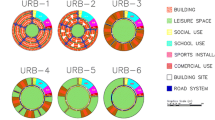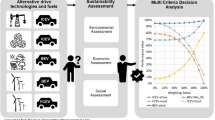Abstract
Purpose
This paper aims to compare the environmental impacts of LNG in different life cycle stages and for various usages by applying life cycle assessment (LCA). According to different usage processes, we set three scenarios including S1-hydrogen production, S2-electricity generation, and S3-vehicle fuel to evaluate their environmental impacts. Furthermore, in order to satisfy better city development, an optimization analysis was made to identify the optimal distribution structure of LNG.
Methods
The environmental impact analysis of LNG was conducted using life cycle assessment and CML2001 method. LCA was performed based on the ISO 14040 standard using GaBi 5.0 software. Four impact categories (i.e., global warming potential (GWP), acidification potential (AP), eutrophication potential (EP), and photochemical ozone creation potential (POCP)) were considered. Sensitivity analysis was also made by means of GaBi 5.0 software. Crystal Ball software was applied to make the optimization analysis for different LNG usage scenarios. The minimum environmental impact factor was taken as the objective function to confirm the optimal distribution structure of LNG.
Results and discussion
The LCA results indicate that the environmental impacts of the gasification and usage stages far outweigh that of the transportation stage, and the highest environmental impact category for each scenario is GWP. The largest contribution factor to GWP of S1 is the production supply of imported electricity, whereas the largest contribution factor to GWP of S2 and S3 is the emissions. The optimization analysis indicate that when imported LNG is allocated 25% for hydrogen production, 73% for electricity generation and 2% for vehicle fuel, the GWP and cost of the total LNG usage are both minimum.
Conclusions
Environmental analysis on different LNG usage scenarios allows the identification and selection of comprehensive LNG usage plans with the minimum environment impacts and lowest cost. For different LNG usage scenarios, the GWP of LNG used for vehicle fuel is the highest and for hydrogen production is the lowest. The production supply of imported electricity and the emissions are the two largest contribution factors to LCA results as well as the sensitivity analysis results of the three scenarios. The optimization analysis method and results can provide technology reference for scientific urban planning of LNG application and allocation.



Similar content being viewed by others
References
Agrawal KK, Jain S (2014) A life cycle environmental impact assessment of natural gas combined cycle thermal power plant in Andhra Pradesh, India. Environ Dev 11:162–174
Ally J, Pryor T (2007) Life-cycle assessment of diesel, natural gas and hydrogen fuel cell bus transportation systems. J Power Sources 170(2):401–411
Arteconi A, Brandoni C, Evangelista D et al (2010) Life-cycle greenhouse gas analysis of LNG as a heavy vehicle fuel in Europe. Appl Energ 87(6):2005–2013
Bai L, Sun QH, Qiao Q (2010) The review of life cycle assessment in the domestic research progress. J Anhui Agri Sci 38(5):2553–2555
Barnett PJ (2016) Life cycle assessment (LCA) of liquefied natural gas (LNG) and its environmental impact as a low carbon energy source. Dissertation, University of Southern Queensland
Bernier E, Maréchal F, Samson R (2012) Optimal greenhouse gas emissions in NGCC plants integrating life cycle assessment. Energy 37(1):639–648
Brynolf S, Fridell E, Andersson K (2014) Environmental assessment of marine fuels: liquefied natural gas, liquefied biogas, methanol and bio-methanol. J Clean Prod 74:86–95
Burchart-Korol D, Korol J, Czaplicka-Kolarz K (2016) Life cycle assessment of heat production from underground coal gasification. Int J Life Cycle Assess 21(10):1–13
Cao WS (2008) Study on natural gas purification and eliquefaction process of small scale LNG project. Dissertation, Shanghai Jiao Tong University
Dinca C, Rousseaux P, Badea A (2007) A life cycle impact of the natural gas used in the energy sector in Romania. J Clean Prod 15(15):1451–1462
Fan QX, Ao HG, Meng C (2007) Life cycle assessment. Environ Sci Manag 32(6):177–180.17
Fu ZH (2010) Life cycle assessment of carbon emission from synthetic natural gas (SNG) and its horizontal comparison analysis. Natur Gas Ind 30(9):100–104
Gu AZ (2003) Liquefied natural gas (LNG) technology. China Machine Press, Beijing
Guo KC (2007) Usages and security of liquefied natural gas (LNG). China Petrochemical Press, Beijing
Han KM (2014) The feasibility study for the LNG project of Ji Lin Ji Yuan Company. Dissertation, Ji Lin University
Heath G, Meldrum J, Fisher N et al (2014) Life cycle greenhouse gas emissions from Barnett Shale gas used to generate electricity. J Unconventional Oil Gas Resour 8:46–55
Hu ZY, Tan PQ, Lou DM (2007) Life cycle energy and environment assessment of gasoline and its alternative fuels. Journal of Tong Ji University (Natural Science) 35(8):1099–1103
Huo LJ (2003) The review of life cycle assessment (LCA). China Packaging 1:42–46
ISO 14042 (2000) Environmental management—life cycle assessment—life cycle impact assessment. International Standards Organisation (ISO), Geneva
Jaramillo P, Griffin WM, Matthews HS (2007) Comparative life-cycle air emissions of coal, domestic natural gas, LNG, and SNG for electricity generation. Environ Sci Technol 41(17):6290–6296
Li JH, Zhang Y, Shao S et al (2015) Comparative life cycle assessment of conventional and new fused magnesia production. J Clean Prod 91:170–179
Liang KM (2015) Cleaner production audit based on LCA: a case study of iron-making enterprise. Dissertation, Dalian University of Technology
Liu SS (2013) The research on the heat transfer performance of ambient air liquefied natural gas vaporizers. School of Municipal and Environmental Engineering in Harbin Institute of Technology
Liu P, Zhan SH, Huang K (2012) The emission reduction effect of liquefied natural gas instead of traditional energy. Urban Management Sciences and Technology 6:52–55
Lu ZG, Gao ZY, Pi LS et al (2016) The status, problems and countermeasures of NG industry development in China. Natural Gas Technology and Economy 10(5):1–4 81
Ma GG, Wu XN, Wang YC (2012) Liquefied natural gas (LNG) technology. Petroleum Industry Press, Beijing
Petrescu L, Müller CR (2014) Life cycle assessment of natural gas-based chemical looping for hydrogen production. Energy Procedia 63:7408–7420
Phumpradab K, Gheewala SH, Sagisaka M (2009) Life cycle assessment of natural gas power plants in Thailand. Environmental Impact of Electricity Generation Technology 14:354–363
Safaei A, Freire F, Antunes CH (2015) Life-cycle greenhouse gas assessment of Nigerian liquefied natural gas addressing uncertainty. Environ Sci Technol 49:3949–3957
Şevik S (2015) An analysis of the current and future use of natural gas-fired power plants in meeting electricity energy needs: the case of Turkey. Renew Sust Energ Rev 52:572–586
Singh B, Strømman AH, Hertwich E (2011) Life cycle assessment of natural gas combined cycle power plant with post-combustion carbon capture, transport and storage. Int J Green Gas Con 5:457–466
Skone T, James R (2010) Life cycle analysis: natural gas combined cycle (NGCC) power plant. US, National Energy Technology Laboratory
Szczygieł I, Stanek W, Szargut J (2015) Usage of the Stirling engine driven with cryogenic exergy of LNG (liquefied natural gas) for the production of electricity. Energy 1–7
Tan XY (2012) Strategy for sustainable development on imported liquefied natural gas (LNG) of China. Dissertation, China University of Geosciences
Tian YZ (2003) Achieve cleaner production by life cycle assessment method. Dissertation, Chongqing University
Tu XY, Xu JQ, Chen YS et al (2013) An evaluation of differences between LNG and diesel commercial vehicle’s life cycle energy consumption. China Mechanical Engineering 24(23):3211–3215
Valente A, Iribarren D, Dufour J (2017) Life cycle assessment of hydrogen energy systems: a review of methodological choices. Int J Life Cycle Assess 22(3):346–363
Wang LG (2013) Research on the technology of LNG receiving terminal. Dissertation, Northeast Petroleum University
Wu R, Ren YL, Yong J et al (2004) A EEE and life cycle assessment of four natural gas based automotive fuels. Systems Engineering-theory and Practice 9:114–120
Xiang C (2007) Alternative energy sources and the development of LNG industry in China. Sun Yat-sen University Forum 27(2):78–82
Xiong GD, Mao YL (2005) LNG storage and transportation. Natural Gas And Oil 23(2):17–20
Yang ZY (2003) Natural gas will become the main source of city gas in China. Oil and natural gas chemical industry 32(3):126–128 133
Yang G, Wang DH (2013) Overview of natural gas engineering. China Petrochemical Press, Beijing
Yu FL (2014) The empirical study on the relationship between energy and economic development in China. Dissertation, Central South University
Zhang YP, Xu YF, Sun MY (2009) Life cycle energy consumption analysis between LNG and CNG supply technology. Chinese city gas association professional committee of the LNG CBM liquefied theme conference in 2009
Zhu LN (2006) Alternative vehicle fuel scheme based on life cycle of comprehensive evaluation. Dissertation, Chong Qing University
Acknowledgements
This study was supported by the Major Science and Technology Program for Water Pollution Control and Treatment (2012ZX07202-001). This study was also supported by the Program of Introducing Talents of Discipline to Universities (B13012).
Author information
Authors and Affiliations
Corresponding author
Additional information
Responsible editor: Zuoren Nie
Rights and permissions
About this article
Cite this article
Zhang, Y., Jiang, H., Li, J. et al. Life cycle assessment and optimization analysis of different LNG usage scenarios. Int J Life Cycle Assess 23, 1218–1227 (2018). https://doi.org/10.1007/s11367-017-1347-2
Received:
Accepted:
Published:
Issue Date:
DOI: https://doi.org/10.1007/s11367-017-1347-2




